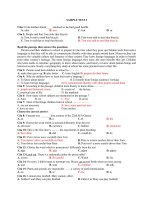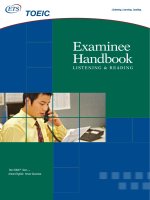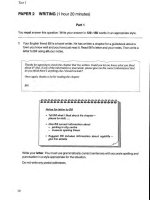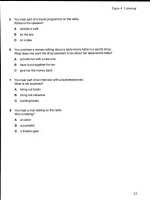Business English Certificate Reading higher C1 level sample test 2
Bạn đang xem bản rút gọn của tài liệu. Xem và tải ngay bản đầy đủ của tài liệu tại đây (195.91 KB, 25 trang )
Ðây là phiên bản html của tệp
Google tự động tạo ra những phiên bản html của các tài liệu khi chúng tôi thu thập thông tin từ web.
Mẹo: Để tìm nhanh cụm từ tìm kiếm của bạn trên trang này, nhấn Ctrl+F hoặc ⌘-F (Mac) và sử dụng thanh tìm.
Page 1
BUSINESS ENGLISH CERTIFICATE
Higher
Reading
SAMPLE TEST 2
Time
1 hour
INSTRUCTIONS TO CANDIDATES
Do not open this question paper until you are told to do so.
Write your name, centre number and candidate number on your answer sheet if they are
not already there.
Read the instructions for each part of the paper carefully.
Answer all the questions.
Read the instructions on the answer sheet.
Mark your answers on the answer sheet. Use a pencil.
You must complete the answer sheet within the time limit.
At the end of the test, hand in both this question paper and your answer sheet.
INFORMATION FOR CANDIDATES
There are 52 questions in this paper.
Each question carries one mark.
PV1
Copyright © UCLES 2018
500/2704/9
Cambridge English Level 2 Certificate in ESOL International (Business English)
Page 2
PART ONE
Questions 1 – 8
• Look at the statements below and at the five paragraphs from an article about human capital
management.
• Which paragraph (A, B, C, D or E) does each statement 1 – 8 refer to?
• For each statement 1 – 8, mark one letter (A, B, C, D or E) on your answer sheet.
• You will need to use some of these letters more than once.
• There is an example at the beginning, (0).
Example:
0 Many companies need to provide customer-facing staff round the clock.
0
ABCDE
1
Making a saving could prove crucially important in some instances.
2
A distinction must be made between two requirements.
3
Data drawn from different departments can give a useful overview.
4
Companies will only thrive if they deploy their workforce effectively.
5
Close examination shows that a belief is unfounded.
6
Reliance on a particular tool may lead to a false conclusion.
7
A particular method should be used to reveal underlying inefficiencies.
8
Organisations sometimes fail to take advantage of available resources.
2
Page 3
Human Capital Management
Using software to optimise workforce management
A In an increasingly service-orientated global economy, more and more organisations have to
have large numbers of employees covering frontline roles 24 hours a day. For those
organisations, the workforce accounts for a large proportion of costs. The way it is managed
and utilised is a critical success factor and fundamental to profitability and growth. Managers
can ensure that the large workforces on which they depend remain motivated and productive,
but this can only be achieved by facilitating closer collaboration between operations, HR and IT
professionals within the organisation.
B Workforce management software exists which integrates with finance and payroll systems,
providing a comprehensive picture of human resources. Using it properly enables
organisations to take a more holistic approach to the way they contract with and optimise the
time of their employees. This approach is often described as ‘human capital management’.
Surprisingly, many organisations already have much of this functionality or, at least, the
potential to develop it within their existing software systems. However, this doesn’t always
happen, largely due to poor internal collaboration, especially between the operations, HR and
IT functions of the organisation.
C When trying to achieve the most efficient and economic deployment of people, it’s vital to
remember that efficiency and economy are not necessarily the same thing. Having the right
number of people working is one aspect, but rates of pay must also be taken into account. The
key is to get a cross-functional team working on the way labour costs are measured and
controlled. Budget variance reports must be used with caution – just because a department is
below budget, it does not mean that the workforce is being managed as effectively as possible.
D A more sophisticated approach requires information in the payroll system, such as time and
attendance records and wage payments, to be combined with information in operational
systems, such as service requirements. This allows for the analysis of planned and actual
expenditure and enables managers to drill down and discover reasons for overspending. Even
well-managed organisations have shaved 1–2% off labour costs with this approach. That may
– not seem much, but in the current climate it can mean the difference between profit and loss
for labour-intensive companies.
E Many organisations think they know what their optimum workforce is, but reviewing the data
often exposes false assumptions based on outdated methods of assessing resourcing levels.
Only when the organisation understands the dynamics of its labour expenditure will it be in a
position to move towards ‘workforce optimisation’. This is a more strategic challenge and
demands a greater input from the HR function. Changes of many kinds can be made that lead
to a more flexible, satisfied workforce with resulting improvements in service performance.
Turn over ►
3
Page 4
PART TWO
Questions 9 – 14
• Read the article below about finding business premises.
• Choose the best sentence from the opposite page to fill each of the gaps.
• For each gap 9 – 14, mark one letter (A – H) on your answer sheet.
• Do not use any letter more than once.
• There is an example at the beginning, (0).
Finding a workplace
Now that you are in business, you will need
a decent workplace. For most companies,
property is the second-highest overhead,
after staff, and in a smaller company it can
be the highest. But frequently people do not
treat the issue of finding the right workplace
with the respect it deserves. In doing so,
they expose themselves to all sorts of
liabilities.
Perhaps the first step is to decide whether
you are going to rent or buy. Not many
start-ups buy a property. (0) ......H..….
Buying commercial property can be a great
investment, but now is probably not the time
to do it.
That leaves a choice between a long-term
lease and serviced accommodation. This is
a question of balancing cost against
flexibility. With serviced offices, all
your outgoings – rent, business rates, bills,
location is far less critical. You need to
have a clear idea of what your requirements
are, in terms of size, facilities, infrastructure
and planning consents. Size is a difficult
issue for any growing business. As a rough
guide, you need about 6 square metres per
person in a call centre, and 12–13 square
metres per person in an office environment.
(11) ............ Business parks and industrial
estates often have the advantage that they
can provide room to expand when you need
it.
Now to the thorny business of the lease
itself and its negotiation. (12) ............ So
don’t make that mistake. Show that you are
a sound bet, with references, accounts,
bankers and so on. The landlord may only
be concerned about the rent, but if you
make your company attractive, the landlord
is far more likely to negotiate a lease on
equitable terms.
repairs and furnishings – are generally
wrapped up into a monthly charge.
(9) ............ With a conventional leasehold,
on the other hand, the main benefits are
lower outgoings and the opportunity to fit
out the property in line with your needs.
Finding the right home for your business is
not the same as choosing a place to live.
(10) ......…... If you are a retailer, clearly,
you will want to find a spot on the high
street, but if yours is an office-based
business,
4
Page 5
Example:
0
ABCDEFGH
You can sometimes get money off by
negotiation, but it is often better to get the
other terms right. (13) ............ Since the
late 1980s, typical periods have come down
from 20 years or more to an average of 6.4
years today. However, longer leases can
be more appealing to industrial businesses.
(14) ............ Also, the capital outlay for
fitting out can be written down over a longer
period.
A
The trick is to allow for how it’s all
E
If residential property is all about
location, with commercial property a
more subtle mix of factors comes
into play: location, specification,
negotiation.
going to look in two or three years’
time.
B
However, there is a premium to pay,
which is the landlord’s profit.
F
Do not be persuaded into taking a
long lease without breaks.
C
And your workplace can also play an
important part in your company
image.
G
Unfortunately, businesses almost
invariably neglect to market
themselves.
D
This is because moving plant and
machinery can be extremely costly.
H
They do not want to commit to a
long-term mortgage at a time of
great uncertainty.
Turn over ►
5
Page 6
PART THREE
Questions 15 – 20
Read the following article about good leadership in business, and the questions on the opposite
page.
For each question 15 – 20, mark one letter (A, B, C or D) on your answer sheet for the answer you
choose.
There has been a trend in recent years for
companies to take ‘expert’ advice on a variety of
core business matters such as mission
statements, values, and corporate and social
responsibility policies and strategy. In many
cases, however, companies go well beyond
legitimate and desirable benchmarking or
acquiring critical knowledge. What they do may
even amount to the outsourcing of the
management thought process and of
management’s engagement with staff and
others. In my opinion, this is unhealthy, because
it tends to remove managers from the effects of
their actions. The role of management –
despite, or maybe because of, the increasing
complexity of business – is to provide the flexible
glue that holds together all the pieces that make
up an organisation and its environment, from
shareholders to staff, and from competitive
forces to markets.
To be the glue in this context, leaders need
significant abilities. They include the normally
touted skills, such as clear communication –
although many firms outsource control of their
communications to a public relations agency,
respond to the future challenges of the
organisation. As a result, progress is more likely
to include the majority than the minority.
Every company has a character that is a product
of its history and its current staff, a set of
underlying values and behaviours which may not
coincide with those claimed in the annual report.
Often, these emerge in times of stress – they
provide the default position when people are
being made redundant or pension plans are
being changed. Understanding this is vital.
Woe betide any manager who can’t sense how
an organisation is feeling.
Such deep values can change, but this rarely
happens by revolution. For most organisations,
it is evolution – often gentle but persistent – that
is likely to carry change further. Too many
managers write a decisive ‘big change’ board
paper rather than a potentially far more effective
recommendation for incremental progress.
Regardless of whether it’s incremental or
sudden, though, change – and hopefully
progress – is more likely to be effective and take
hold if the leaders of an organisation understand
which
ends up writing
the script.
But perhaps
more important
is the often
neglected
skill of
understanding the complex interplay between
interested groups of people. This encompasses
an ability to understand their strategic interests
as well as reading the individuals that you’re
and
underlying
values.
For
me, are
thissensitive
is a way to
in the
which
leaders can
be most
valuable: by appraising the shifting behaviour of
interacting groups of people when they are
made uncomfortable.
dealing with – and having the personal and
interpersonal skills to get results.
The mistake is for company leaders to base
every pronouncement on the indexing of
staff attitudes, corporate social responsibility
benchmarking and a multitude of CEO blogs and
corporate communications. In my view,
leadership is about judgement and about being
respectful to existing values. Leadership
decisions may be manifested in a speech or
even a blog, but the communication must be the
consequence of a management team’s thoughts
and deliberations. Formulaic and clumsy
responses are just no use.
Such astuteness is not about doing enough staff
surveys or producing lots of newsletters –
although these have their place. It’s about
management teams having empathy for the
groups they work with. Such understanding of
the character of an organisation is vital and
provides a solid base for progress. If managers
have an in-depth understanding of the issues
that interest, bother or motivate their staff, they
will be far more successful at engaging people to
6
Page 7
15 What does the writer criticise in the first paragraph?
A a lack of consistency in styles of outsourcing
B the attitude of some managers towards outsourcing
C over-reliance by management on consultants
D the increasing emphasis on such issues as mission statements
16 What opinion does the writer express in the second paragraph?
A The skills that are most useful to managers are often undervalued.
B The strategic interests of different groups often conflict with each other.
C The best advice on communications comes from public relations agencies.
D The ability to communicate effectively in writing is essential for managers.
17 According to the third paragraph, understanding the character of the organisation helps
managers to
A produce good quality internal communications.
B identify the best way to consult the staff.
C ensure they employ the most suitable staff.
D gain staff co-operation in a changing environment.
18 What point is made about company culture in the fourth paragraph?
A It should be presented accurately in the annual report.
B It can be seen in the employees’ responses to problems.
C It is more strongly influenced by managers than other staff.
D It may help to minimise the effects of stress.
19 What does the writer suggest in the fifth paragraph about introducing change?
A It is important to make the reasons for the change clear.
B Companies often choose inappropriate ways of doing it.
C Everyone who will be affected should be consulted first.
D Values are most often changed by external influences.
20 According to the last paragraph, leaders should
A consider not only the message but also the style of delivery.
B absorb information from many sources before making decisions.
C think carefully about whether changes are necessary.
D select the best medium for announcing changes.
Turn over ►
7
Page 8
PART FOUR
Questions 21 – 30
• Read the extract below from the annual report of an oil exploration company.
• Choose the correct word to fill each gap from A, B, C or D on the opposite page.
• For each question 21 – 30 mark one letter (A, B, C or D) on your answer sheet.
• There is an example at the beginning, (0).
Tenex Oil – Annual Report
At Tenex our strategy of (0) ………. growth both from the production
base and from high-potential exploration is backed by a solid
financial position. Existing cash (21) ............ , bank borrowing
facilities and strong cash flows will allow us to fund existing and new
development projects. Our year-end net cash position of US$79.0
million (22) ............ strong cash generation and a disciplined
(23) ......…... to expenditure.
Our professionals use the latest technological tools to keep us at the
forefront of the industry and we employ the best available specialists
in all of the projects that we (24) ............ .
We manage our portfolio to ensure that our focus is on the best
prospects. For our development projects, we consider all the
possible options, including appropriate new technology and
(25) ............ the range of possible outcomes before selecting the
optimal design.
We (26) ............ considerable value on the creativity of our
geologists, geophysicists and engineers. It is this that enables us to
work in previously overlooked regions, so that, (27) ............ with new
scientific concepts, innovative technologies and state-of-the-art
equipment, we can operate in such regions more successfully than in
the past.
Tenex aspires to be an industry leader in social performance, which
covers the areas of social responsibility, health and safety, and
environmental impact. Our (28) ............ policy is to ensure that the
risks and impacts of our activities are reduced to ‘as low as
reasonably practicable’ at all times. We fix targets with (29) ............
to our historical performance, the performance of our peer group and
standards (30) ............ by external agencies.
8
Page 9
Example:
A
0
delivering
B
placing
C
sending
D
carrying
ABCD
21 A
property
B
means
C
possessions
D
resources
22 A
expresses
B
reflects
C
points
D
proposes
23 A
approach
B
system
C
method
D
process
24 A
commit
B
engage
C
participate
D
undertake
25 A
think
B
assess
C
suppose
D
conclude
26 A
lie
B
rest
C
place
D
leave
27 A
assigned
B
dispensed
C
armed
D
protected
28 A
stated
B
described
C
outlined
D
explained
29 A
mention
B
concern
C
connection
D
reference
30 A
asked
B
set
C
made
D
met
Turn over ►
9
Page 10
PART FIVE
Questions 31 – 40
• Read the article below about team-building training courses.
• For each question 31 – 40, write one word in CAPITAL LETTERS on your answer sheet.
• There is an example at the beginning, (0).
Example:
0
DO
If you’re asked to organise a team-building course, the first thing
Teambuilding
keeps staff
on side
to (0) ..…....... is to decide what you hope to achieve. Secondly, plan for the
follow-up.
Courses to improve communication and boost morale are (31) ............ the
increase. A company called GRY, for example, has recently started offering
open-air courses which seek to bring (32) ............ barriers and build trust.
Company founder Henry Blackwell says: ‘It goes without saying that teambuilding events are popular with participants, but, in my experience, nearly
(33) ............ motivational weekends treat the symptoms of a problem,
(34) ............ the root cause. Research has highlighted that 94 percent of
employees aren’t doing what they want to be doing in their work. Unless
organisations tackle this issue, investment in team-building will be ineffective.’
Piers Lawson, director of A-Event, agrees: ‘It can be difficult to treat a
problem that is deep-rooted, but if a company is serious about rebuilding a
team, particularly (35) ............ that involves a group of managers or people
who work in the same department, we have contacts who can assist.’
However, he admits that the majority of clients simply require a fun day or
weekend during (36) ............ staff can get to know their colleagues outside
the office. Piers points out that in the past, by (37) ............ the most
significant indicator of a company’s success (38) ............ its financial
resources, but this has now shifted to its employees: ‘It’s about attracting
(39) ............ right talent and ensuring these people learn to work as a team.
You also have to decide what the team should be doing after the event that
they are not doing now, and set your budget some time (40) ........…. you
think about seeking quotes from course providers.’
10
Page 11
PART SIX
Questions 41 – 52
• Read the text below about winning new customers.
• In most of the lines 41 – 52 there is one extra word. It is either grammatically incorrect or does
not fit in with the meaning of the text. Some lines, however, are correct.
• If a line is correct, write CORRECT on your answer sheet.
• If there is an extra word in the line, write the extra word in CAPITAL LETTERS on your answer
sheet.
• The exercise begins with two examples, (0) and (00).
0
Examples:
00
UNLESS
CORRECT
Winning new customers
0
New customers are the oxygen every business needs to grow. But unless customer
00 acquisition remains an enigma to many business owners: they just don’t
41 know where to start when it comes to try finding new customers. The problem many
42 have is that after they exhaust their contact base and then do not know where
43 to go next. Word of mouth will only get you so far. You need take a strategic
44 approach. Getting new clients often depends on understanding your existing ones first.
45 Only by then, once you’ve analysed the real motivation of each of your customers,
46 can you acquire new ones. And that is where many businesses go out wrong. They
47 are so busy scanning the horizon for new prospects, they equally fail to look at existing
48 relationships. So, do research into customers’ buying patterns and learn from it
49 marketing campaigns that have been successful. Realisation of what makes customers to
50 tick will give you insights into the new market you are aiming at. Put yourself
51 in the place of being the customer – what sales message would you want to hear? Of
52 course it is rarely easy, but if by looking at your business with the eyes of a customer,
you are better prepared to expand your market.
11
Page 12
BLANK PAGE
12









